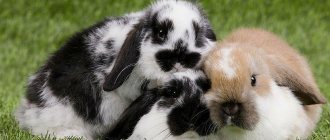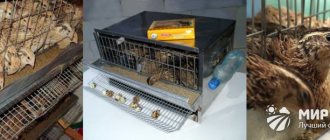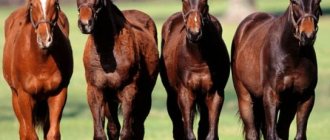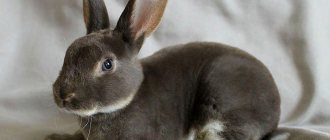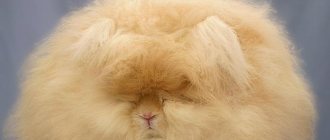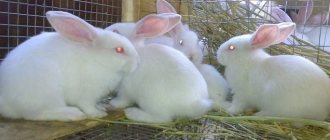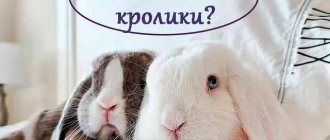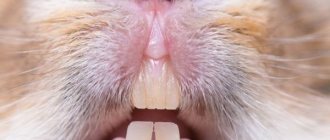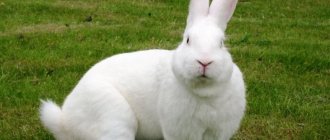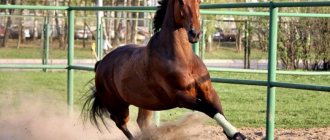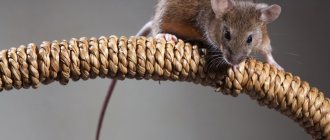Dwarf rabbit Hermelin, Polish, Ermine - this is all the name of one breed of miniature animals. These eared dogs are popular among breeders. In addition to the fact that they live well under the same roof with humans, animals of this type most often become prize-winners of international exhibitions. Breeders note that it is Polish rabbits that are the founders of most decorative species of eared animals.
Origin
There are currently no reliable facts about the origin of the first representatives of the Hermelin rabbit breed. At the same time, it is known that to some extent they have Polish roots, and the first mention of these animals occurs in the mid-nineteenth century. At that time, Hermelins were bred in England and had a white coloration and only a red tint to the eyes. At the beginning of the twentieth century, through the work of breeders in Germany, these rabbits received a blue tint to their eyes, while retaining exclusively white coloring.
Since the first attempts to improve the Hermelin breed, other changes have occurred. Thus, the animals’ external characteristics were preserved and the body size was reduced. Thus, these rabbits were the result of crossing albinos, wild rabbits, as well as silver and Dutch breeds.
The first mentions of Hermelin rabbits come from England
Health
The Hermelin breed was obtained through crossbreeding, which is often inbreeding in nature. Not even every mating produces a result, which is generally unusual for lagomorphs. And Gremlins’ health is very fragile, they do not have strong immunity.
In addition, they have one significant drawback - excessive molting. In order to prevent your pet's gastrointestinal tract from becoming clogged with hairballs, it should be combed frequently and special pastes for hairballs should be periodically introduced into the diet.
To exclude invasive diseases, rabbits are dewormed already at 2.5-3 weeks. After 10 days they must be dewormed again.
At 28 days, mandatory vaccinations begin - the first vaccination against myxomatosis and VGCH is given, at 60 days - against rabies. At 105 days, revaccination is carried out. Then all vaccinations are repeated every six months.
With good care and proper nutrition, Hermelin can live in a family for up to 10-11 years. But you need to be attentive to your pet and remember that even vaccination does not always guarantee one hundred percent protection against infections.
The best way to maintain the health of this sweet and beautiful ermine baby is to comply with sanitary and hygienic standards, a nutritious diet and a timely visit to the veterinary clinic.
Indeed, in addition to viral pathologies, you can encounter diseases such as:
- Heat and sunstroke. Hermelins have a weak heart, and they tolerate overheating very poorly. It should be remembered that the easiest way to “cool down” your pet is by applying a cloth moistened with cool water to the ears.
- Injuries. It is very easy for these fragile babies to get dislocations, bruises and sprains; you should be very careful with them. At the slightest hint of injury, you should immediately contact a veterinarian.
- Dyspeptic phenomena. They most often occur as a result of poor diet. But sometimes, subject to vaccination against major diseases, they can be caused by coccidia. You should immediately take the baby to a veterinary clinic and begin treatment.
- Rhinitis, acute respiratory infections, pneumonia. If they are not infectious in nature, then they are a consequence of hypothermia, colds, or the animal being in a draft.
- Conjunctivitis. If this is not an infection, then, most likely, they were caused by foreign bodies that got into the pet’s eyes and caused redness, tearing, and swelling of the eyelids.
Description of the breed
Breeders managed to achieve not only miniature sizes and changes in eye color, but also preservation of stockiness and shortening of the ears. Today, when purchasing, breeders pay attention to breed standards:
- compact body without a developed transition into a large head;
- body weight from seven hundred grams to one and a half kilograms;
- red or blue eyes (those with blue eyes are valued more);
- a small tail that fits tightly to the body;
- short paws with transparent thin nails;
- uniformly white dense fur without inclusions or spots.
Rabbits of the Hermelin and Chinchilla breeds often participate in exhibitions. If a breeder has similar goals, he should pay attention to strict compliance with standards when purchasing and maintaining. In this case, it is better to buy rabbits only from a trusted pet store or from friends.
Dwarf rabbit Hermelin
Acquisition
In order to purchase a purebred Hermelin, you should contact large nurseries or private breeders with a high reputation. First of all, you need to look at the parents' passports and registration cards. It is advisable not to purchase babies born as a result of inbreeding.
You should pay close attention to the appearance of the little rabbit. The eyes look shiny, clear, the coat is clean, smooth, and lush in the light. The area under the tail must be clean; discharge from the nose and eyes is unacceptable.
Hermelin's purebredness is very easy to establish - it has snow-white wool; White skin; short, narrowly set and neat, erect ears; transparent claws; red or blue eyes.
A good baby Germelina breed or show class can be purchased for a price of 5-6 thousand rubles.
Breed productivity
Polish dwarf rabbits rarely reach a weight of more than two kilograms and are not suitable for fur or meat. However, it is possible to profit by selling purebred animals. The cost of an adult rabbit will be one to one and a half thousand rubles. Meanwhile, females bring two to five cubs per litter with two or three litters per year. Read about lop-eared sheep rabbits at this link.
It is recommended to sell young animals no earlier than a month after birth. At this time, they will acquire sufficient immunity and become stronger.
Maintenance and care
Domestic decorative rabbits are most often kept in cages. It is best to choose a larger cage so that the animal can move around calmly and not gain fat. The minimum area of the room is seventy by seventy centimeters. There should be three main areas inside: for eating, sleeping and toileting. A tray needs to be attached to the bottom of the cage for easy cleaning. The bedding can be made from hay or straw. It will need to be changed regularly. It is also important to place a device in the cage for grinding down the front teeth. This material will tell you about diseases of decorative rabbits.
Polish rabbits need regular walks. It is best to set aside an hour in the morning for this and use a leash. It is important to completely eliminate sharp and loud sounds.
A rabbit cage should be 4 times larger than the animal itself.
Caring for Hermelin rabbits should be carried out according to the following rules:
- nutrition should be as balanced as possible;
- the cage should not be installed near heating devices and radiators;
- You cannot hold rabbits by the ears;
- cleaning of the premises must be carried out at least once every two to three days;
- Bathing a rabbit is prohibited;
- The wool must be kept clean and tidy; for this you will need a set of brushes to comb out pellets and dead hairs.
Rabbits must be handled very carefully. without damaging your ears
Dwarf rabbits shed often, so you need to keep the cage and house clean as carefully as possible.
Character
Hermelins are ideal for keeping at home, as their disposition is gentle and peaceful. They usually sleep peacefully during the day and it is better not to disturb them during rest.
In the evening hours, they will happily take a walk with one of their household members in the park or in the country. Therefore, it is recommended to accustom them to a harness and leash from a young age.
They also behave peacefully when walking around the house, but you should keep an eye on them so that they do not chew furniture, electrical wiring and injure themselves.
Hermelin is perfect for both single people and large families. They happily go into a person's arms, run after toys, and do not offend children.
They are smart enough to remember their name and simple commands. But at the same time, they are very stubborn and willful, so when working with them, you need to be patient.
Feeding
Hermelin rabbits are very sensitive to the quality and composition of their diet. Therefore, nutrition must be correct and balanced. As a rule, breeders purchase special grain mixtures for feeding decorative rabbits. Read about feed for rabbits here. They are an ideal basis for the diet. But besides this, the menu should contain:
- hay and dried grass in season;
- boiled root vegetables (potatoes);
- seasonal fresh vegetables and fruits.
You cannot often feed animals fresh vegetables and fruits. Meat and dairy products are also prohibited (milk is allowed for young animals up to two and a half months), as well as legumes, cabbage, carrots and beets. If purchased feed mixtures do not have enough nutritional components, it is necessary to purchase vitamins and mineral premixes. A mandatory attribute in the cage is clean water in the drinking bowl, and the frequency of feeding is twice a day.
Green food for rabbits
If there is a need to replace any part of the regular diet, it is important to do it slowly and smoothly. A sudden switch even to one product from another can lead to bloating.
Breeding
As noted above, Polish rodents are not highly fertile, however, their breeding and keeping for sale can be considered profitable . Mating is recommended to be carried out at the age of six to eight months, placing the pair in a separate cage. Read about DIY cages. During the mating season, five to seven days are usually sufficient, but keeping the animals together for longer can be dangerous, since the male can be aggressive during this period. Learn about rabies in rabbits from this article.
For reproduction, it is recommended to use mature individuals weighing between 1.1–1.35 kg.
The results of mating can be determined by palpation fifteen days after weaning the male. If fertilization has been completed, “peas” should be felt in the abdomen. And you can determine the imminent birth of a female by the following signs:
- the female rabbit begins to build a nest and pluck out fluff from herself for this purpose;
- the animal begins to get nervous and becomes more active.
Most often, female rabbits of the Hermelin and Risen breeds are good mothers. However, in rare cases, they may lack maternal instinct and then the animal will abandon the rabbits and refuse to feed them. In such cases, it is necessary to lay the offspring nearby and cover them with plucked fur. Read about cages with queen cell for rabbits here.
Rabbits can be separated from their mother as early as a month after birth. Before this, after the first two weeks of feeding with mother's milk, they should begin to be accustomed to "adult" food, giving them grain mixtures and grass.
It is recommended to disturb a female rabbit who has given birth as little as possible. It is better to pay as little attention to the offspring as possible and regularly feed the mother.
Possible diseases
Decorative ermine rabbits are susceptible to various pathologies. Among them:
- gastrointestinal diseases;
- hyperthermic shock (due to overheating);
- injuries;
- ENT pathologies;
- pododermatitis;
- conjunctivitis;
- rickets;
- frostbite;
- contagious runny nose;
- microsporia;
- VGBK;
- myxomatosis;
- staphylococcosis;
- pasteurellosis;
- listeriosis.
In addition to the above pathologies, rabbits may have genetic breed mutations, which are manifested by color defects and atypical appearance of the ears.
| Contents of the Hermelins | |
| pros | Minuses |
| Silence Flexibility to training Possibility of litter box training Economical nutrition No need for personal walking Friendly character Developed maternal instinct | Require attention and communication Males mark territory Scatter food near the cage Frequent molting Specific smell in the place where they are kept Chew furniture and wires when walking around the house Frequently get sick |
Video Rose, baby rabbit of the Hermelin breed
conclusions
- Rabbits of the Hermelin breed are dwarf species and are often used as ornamental animals, so they are practically not suitable for obtaining meat or fur.
- Keeping decorative breeds at home is not difficult , but these animals are picky about food and extraneous noise.
- You can breed and keep rabbits for home care , participation in exhibitions and sale.
- Hermelin rabbits are not capricious , friendly and sociable, which is why they have become widespread throughout the world.
How to choose a good rabbit
It mistakenly seems that all Hermelins are exactly the same, moreover, these rabbits have only white coat color.
A good Hermelin fits the following description: a stocky, small, tightly built snow-white animal with a wide forehead and short ears. The shape of the head is round, the neck is practically not expressed. The ears are the main aspect when choosing; they should be small, round, and close set. Ears that are too fleshy, long or pointy are considered a defect. Short front legs and colorless claws are required. A healthy rabbit is cheerful, lively and active. The eyes are clean and bright, without discharge, slightly moist. The nose is slightly wet or dry, breathing is calm. The coat is thick, shiny and clean. In order not to buy a bad Hermelin or a crossbreed, it is best to visit an existing nursery where they breed this breed and choose the animal you like.
